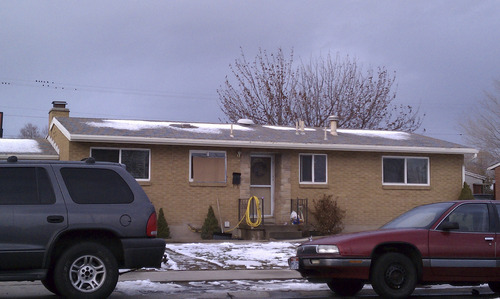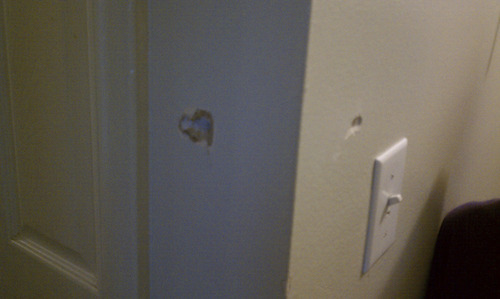This is an archived article that was published on sltrib.com in 2011, and information in the article may be outdated. It is provided only for personal research purposes and may not be reprinted.
Brandon Chief's blood is still on his parents' carpet. Holes in the wall still show the path of a bullet.
Salt Lake County District Attorney Sim Gill, in his first use-of-force ruling, announced that a West Valley City police officer was justified by law in shooting Chief to death.
But Chief's family still has questions about how police handled the case, and their attorney is calling for more oversight of officers and prosecutors who investigate fatal police shootings.
"They wouldn't tell us anything," said Etta Chief, Brandon's mother, who arrived at her home Dec. 17 to learn her 21-year-old son had been taken to a hospital. Officers would not tell Etta Chief how he had gotten hurt or which hospital he had gone to. She spent the last hour of her son's life waiting at the police tape.
Gill outlined the basics in a media statement: Police were called to the Chiefs' house, near 3700 West and 4200 South, during a domestic dispute. They went inside, Brandon threatened them with a knife, and an officer shot him three times.
The Chiefs say there are more details to piece together.
Brandon Chief's niece, 15-year-old Tayzha Chief, said she called police because Brandon pushed her and her cousin Alisha into the yard when they teased him over a flat tire on his car.
Gill wrote that officers arrived to find one of the girls had "obvious injuries," and the girls gave them permission to go into the house.
Tayzha says the officers only asked if her uncle was inside. Then they walked through the door.
"It took 3 seconds" for the gunfire to start, she said.
Jim Slavens, the family's attorney, said police could have done more to assess or de-escalate the situation before going into the house.
"Nobody asked if he had a weapon, if anyone else was in there with him, what room he was in, what he had done," Slavens said. "Nobody tried to talk to anyone first. ... Now [Tayzha] is devastated. This eighth-grade girl feels like it's her fault because she called 911. We can't console her."
Tayzha Chief could not speak about whether she feels responsible. She only nodded and broke into tears.
When police arrived at the house, Brandon Chief's agitation hadn't subsided, his family conceded. He had broken two windows and jabbed at his bedroom wall with a paring knife from the kitchen, said Frank Chief, Brandon's father, who was also at home at the time. Brandon's sister has told The Salt Lake Tribune that he was drunk and high.
Tayzha, Frank and Alisha Chief said Brandon never threatened them with the knife, and Frank said he suspects his son was taking it back to the kitchen when he met the officers in the hallway.
The three officers found Brandon Chief in a narrow hallway that leads to the bedrooms, Gill wrote. Officer Levi Lloyd, who was in the lead, told Brandon that he needed to talk to him, and Brandon turned his back and walked away, Gill wrote.
"Suddenly, Brandon turned back around and faced Officer Lloyd with a knife in his hand. Brandon started walking toward the officers with the knife pointed at them in a threatening manner. Officer Lloyd began backing up and told Brandon repeatedly to drop the knife. Brandon, however, continued to advance with the knife," Gill wrote.
Lloyd shot Brandon Chief three times.
West Valley City police spokesman Sgt. Mike Powell declined to comment on the Chief family's concerns that responding officers took rash action and failed to keep them informed as to their son's status.
Gill's decision only addressed the question of whether the shooting amounts to a crime — not any other aspect of how police handled the case. State law allows for deadly force if an officer reasonably believes that is necessary to prevent death or serious bodily injury.
"When we look at this, our scope is very narrowly focused on the ... criminal statutory review that we are obligated to make," Gill said.
A prosecutor is the wrong person to rule on police conduct, Slavens argued.
"There has to be cooperation between police and prosecutors in prosecuting criminal charges," he said. "I think it's pretty easy to see the conflict that would be caused if the prosecutor's office found that the law enforcement officers' actions are inappropriate. It would put a strain on that relationship."
Gill said he does not hold law enforcement officers above the law.
"Ours is an independent review," he said. "If there is criminal wrongdoing by a law enforcement officer or any person regardless of status or position, our office will prosecute those cases."
In large counties nationwide, it is the norm for prosecutors to review uses of force by police within their own county, said Scott Burns, executive director of the National District Attorneys Association and former Iron County prosecutor.
But it isn't the only option. In some cases, prosecutors hand the cases to neighboring county attorneys or to a grand jury.
"If the D.A. believes it's a close call, and/or someone may claim there was some conflict of interest, then there's always the option to say, 'OK, we let the citizens decide this one,' " Burns said.
The Chiefs wanted to review the records themselves, but police and prosecutors initially denied the request saying the case was still an open one.
"We won't know until months after the event — after memories have dissipated, after people get in the posture of protecting themselves against liability," Slavens said. "Here we're almost two months removed, and we still have no means of making sure that the thing is fully investigated. The longer it takes us to get the police reports, the less confidence we have in the whole procedure."
West Valley City has Professional Standards Review Board of five civilian volunteers and one police officer, who meet monthly to review police use-of-force investigations and make recommendations to the chief. But their reviews happen after all internal investigations are complete.
That matches the role of most police departments' independent review boards nationwide, said Merrick Bobb, president of the Police Assessment Resource Center — an organization that advises cities on police oversight.
But some cities are moving to more active civilian reviews.
"There are agencies that have civilian oversight ... in which monitors go to the scene of an officer involved shooting, are permitted full access, can interview witnesses, can sit in on the interviews of other witnesses and can follow the internal affairs investigations on a moment-to-moment basis and have input," he said.
Independent monitoring is a city-level decision; but Gill said he plans to examine the review process at the prosecutor's office. Gill made determinations in Chief's shooting and one other case using the protocol established by former District Attorney Lohra Miller. He said he plans to meet with the county's police chiefs to hear about their experience with use-of-force evaluations and learn whether any changes should be made.
"As the incoming district attorney, I have a commitment to ... review what is working and what is not working, and to open up channels of communication to make sure that the law enforcement and prosecutors responsible are as open and transparent as can be," Gill said. "That's an always-evolving process."







